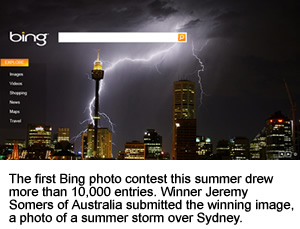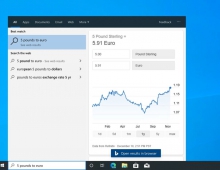
Bing Hosts Homepage Photo Contest
Photographers have a chance to see their work featured on the Bing home page for a day with the "Home Sweet Homepage" photo contest.
One of the most popular features of Bing's home page, launched in May, has been its use of photographs taken from around the world. Embedded within each photo are mouse-able "hot spots" that offer more information about what's in the photo.
Each day, Bing editorial lead Stephanie Horstmanshof receives e-mails complimenting the photos. Along with those come many questions from people asking how to submit their own photos.
So a new Bing photo contest, called "Home Sweet Homepage," asks photographers to do just that; submit photos demonstrating what's special about their hometown. The winner's work, in part determined by a public vote, will become the Bing backdrop for a day. "This contest is how we allow our users to both submit and decide what we display," says Horstmanshof.
To participate, become Bing's friend on Facebook and download the "Bing Snap" application. Users can then submit a photo to the contest before the deadline on Sunday, Dec. 13, or vote on others' photos. The top vote-getting photos will move on to the contest's second round, where the Bing homepage editorial team will pick finalists. The finalists will once again be voted on, and the winner will be announced on Dec. 21. His or her photo will be featured on Bing on Jan. 6.
 The first Bing photo contest earlier this year, with a "summer travel" theme, drew more than 10,000 entries. The winner, Australian Jeremy Somers, submitted a photograph of a storm over Sydney, shot from his grandmother's apartment building.
The first Bing photo contest earlier this year, with a "summer travel" theme, drew more than 10,000 entries. The winner, Australian Jeremy Somers, submitted a photograph of a storm over Sydney, shot from his grandmother's apartment building.
"Our biggest criteria? Whether it makes you want to find out more about whatever it is," Horstmanshof says. "We go for diversity. Photos have to be interesting and beautiful and get people wanting to explore."
Bing has agreements with 10 different stock photo providers. Horstmanshof and her team are constantly on the lookout for compelling photos, and every two weeks the team meets to review nominated images and "grab the ones that jump out at us," she says. Once the photos are chosen, writers and editors get to work creating four "hot spots" for each day. When users roll their mouse over a hot spot on the photo, they get an informational tidbit and a link to learn more about what they're looking at.
Each day, Bing editorial lead Stephanie Horstmanshof receives e-mails complimenting the photos. Along with those come many questions from people asking how to submit their own photos.
So a new Bing photo contest, called "Home Sweet Homepage," asks photographers to do just that; submit photos demonstrating what's special about their hometown. The winner's work, in part determined by a public vote, will become the Bing backdrop for a day. "This contest is how we allow our users to both submit and decide what we display," says Horstmanshof.
To participate, become Bing's friend on Facebook and download the "Bing Snap" application. Users can then submit a photo to the contest before the deadline on Sunday, Dec. 13, or vote on others' photos. The top vote-getting photos will move on to the contest's second round, where the Bing homepage editorial team will pick finalists. The finalists will once again be voted on, and the winner will be announced on Dec. 21. His or her photo will be featured on Bing on Jan. 6.
 The first Bing photo contest earlier this year, with a "summer travel" theme, drew more than 10,000 entries. The winner, Australian Jeremy Somers, submitted a photograph of a storm over Sydney, shot from his grandmother's apartment building.
The first Bing photo contest earlier this year, with a "summer travel" theme, drew more than 10,000 entries. The winner, Australian Jeremy Somers, submitted a photograph of a storm over Sydney, shot from his grandmother's apartment building.
"Our biggest criteria? Whether it makes you want to find out more about whatever it is," Horstmanshof says. "We go for diversity. Photos have to be interesting and beautiful and get people wanting to explore."
Bing has agreements with 10 different stock photo providers. Horstmanshof and her team are constantly on the lookout for compelling photos, and every two weeks the team meets to review nominated images and "grab the ones that jump out at us," she says. Once the photos are chosen, writers and editors get to work creating four "hot spots" for each day. When users roll their mouse over a hot spot on the photo, they get an informational tidbit and a link to learn more about what they're looking at.





















